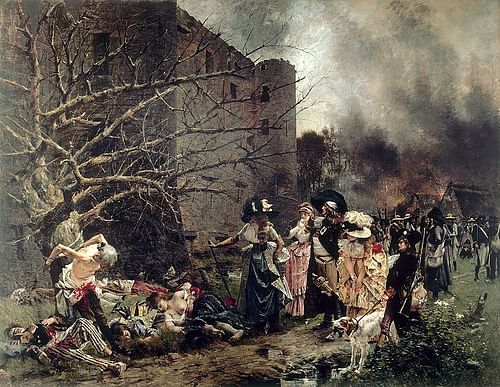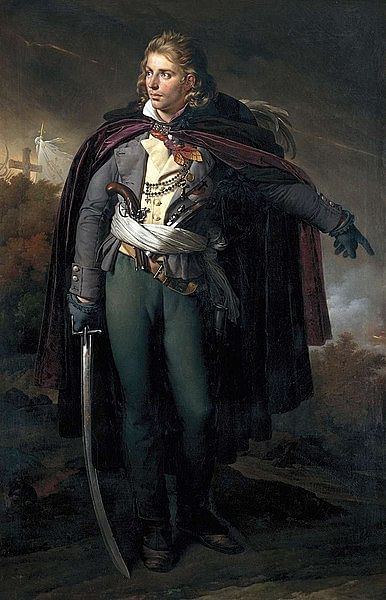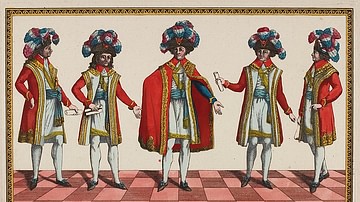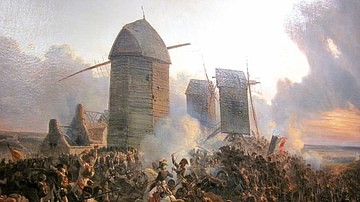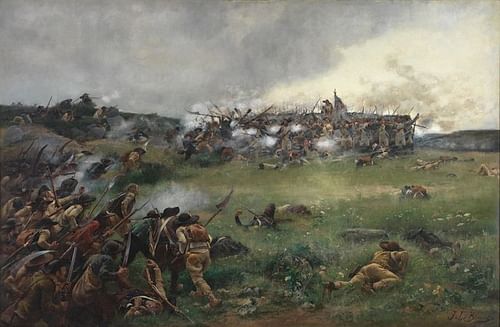
The War in the Vendée was a counter-revolutionary uprising that took place in the Vendée department of France from 1793 to 1796, during the French Revolution (1789-99). In response to the French Republic's attempts to impose conscription, the Vendeans rebelled and formed themselves into a Catholic and Royal Army. The ensuing civil war is primarily remembered for its excessive brutality.
The war is often viewed symbolically as a final, climactic struggle between the remnants of the Ancien Régime and the French Revolution, but this notion disregards the rebels' true motivations, which can be boiled down to outrage over perceived acts of tyranny by the revolutionaries in Paris. The Revolution's program of dechristianization alienated the religiously conservative Vendeans, who were further angered when the French Republic announced the possibility of conscription in February 1793 to raise soldiers to fight in the War of the First Coalition (1792-97). It was only after the Vendée had already rebelled that it took up the royalist cause. As historian François Furet points out, the Vendean population arose not in response to the destruction of the Ancien Régime, but because of the construction of a new regime they believed to be more oppressive.
The staggering death toll has turned it into one of the most divisive episodes of the French Revolution, a reputation that continues to this day. Most infamous was the massacre of Vendeans by the Republic's 'infernal columns'. Acting on orders from the National Convention to turn the Vendée into an uninhabitable desert, the so-called infernal columns of French soldiers traversed the region, indiscriminately burning, pillaging, and killing. It is estimated that at least 170,000 inhabitants of the Vendée were killed during the war, amounting to 20% of the entire population. For this reason, some historians have called the War in the Vendée one of the first modern genocides, a label that is still hotly debated.
Origins
With the outbreak of Revolution in 1789, there was little to mark the Vendée out as a bastion for insurrection. Located on France's western coast, just south of the Loire River, the Vendée was a rural landscape bypassed by all major roads, leaving it largely isolated from the rest of the country. Its terrain consisted mostly of bocage, which would later prove a nightmare for French Republican armies trying to pass through; a mixture of small hills, ravines, and woodland, the Vendée was interspersed with thistles, flowering gorse, and streams that would often overflow and flood what few roads did exist. Of the roughly 800,000 people who lived there, most were destitute peasant farmers who lived in small hamlets or on farms, as the region boasted few large settlements.
The Vendée was religiously and politically conservative compared to most of the rest of France. Its relative isolation fostered a strong and genuinely popular religious community, centered around priests who were often born and raised in the communities they served. Due to the efforts of missionary Louis de Montfort in the late 18th century, most Protestants had been driven out of the Vendée, allowing the Catholic Church to deeply embed itself in daily life; the Church was the glue that bound otherwise isolated neighbors together. Vendean peasants also generally enjoyed better relationships with their nobles than most of the rest of the country. This is partially because Vendean nobles tended to reside on their manorial estates, as opposed to other French nobles who distanced themselves from their seigneurial farmers by living in cities. Such a sense of familiarity caused Vendean peasants to feel less bitterly toward their nobles in general.
Still, the Vendeans were not morally opposed to the Revolution at its start. Just as poor and hungry as the rest of France, the Vendée welcomed the Estates-General of 1789 as an occasion for change, petitioning it for lower taxes, less corruption in the courts, and better roads. This acceptance would soon turn to distaste, as the revolutionaries began pursuing policies that were hostile to the Catholic Church. In November 1789, the National Assembly ordered the confiscation and nationalization of church properties, and in July 1790, it passed the Civil Constitution of the Clergy, which effectively subordinated the French Catholic Church to the state and required all clergymen to swear oaths of loyalty to the new constitution.
The Civil Constitution caused a schism within France's religious community, especially after the Pope denounced it and condemned the Revolution altogether. All but seven of France's 160 bishops refused to take the oath, as did half of all parish priests. These clergymen would become known as refractory, or nonjuring, priests, while those who did swear the oath were called constitutional, or juring, priests. Many countryside priests, including most in the Vendée, were refractory. As time wore on, the Assembly began to view refractory priests as enemies of the Revolution and ordered them to be replaced by constitutional ones, who preached revolutionary doctrine just as they did the word of God. This greatly offended the Vendeans, whose sense of religion was so intertwined with their sense of community.
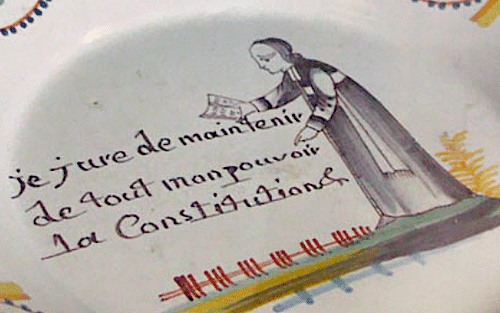
The Vendeans continued to simmer with anger, although they let their displeasure be known by refusing to come to the constitutional priests' sermons, and even by harassing and kicking them whenever they went out in public. Still, the Vendée suffered through other revolutionary events that it generally disagreed with, such as the abolition of the monarchy and the trial and execution of Louis XVI. The tipping point did not come until February 1793, when the new French Republic called for 300,000 additional soldiers to fight in its armies, permitting recruiters to draw lots to see who would be conscripted if they could not find enough volunteers.
Upon hearing this, the anger of the Vendeans burst out. As the townspeople of Doulon put it, "They have killed our king, chased away our priests, sold the goods of our church, eaten everything we have and now they want to take our bodies…no, they shall not have them," (Schama, 694). This sentiment was shared across much of France, as many regions rose in revolt. Although most revolts were quickly crushed, this was not the case in the Vendée, as the Republic had few soldiers stationed in the region. By the time the Republic was able to address the unrest in the Vendée, it had already blossomed into a brutal civil war.
Peasant Revolt
The War in the Vendée did not begin with aristocrats, but with peasants. In March 1793, thousands of them descended on villages in which recruiters were said to be operating; one of these was the village of Machecoul. On 11 March, an army of peasants swarmed the village armed with pitchforks, skinning knives, and hunting guns. The National Guard quickly fled in the face of the horde, leaving the recruiter to be killed by a pike thrust to the heart. The slaughter did not end with his death, however; houses belonging to anyone identified with the Republic were ransacked, and their inhabitants were taken outside and beaten. One constitutional priest was ripped from his church and bayoneted for ten minutes in the street. Over 400 prisoners were taken, who were subjected to summary judgements and executions over the course of the next few days. Prisoners were chained together and forced into fields to dig ditches, after which they were shot so that they fell neatly in the graves. It was a gruesome scene reminiscent of the previous year's September Massacres in Paris, committed for similar reasons but by the opposite side.
The Massacre of Machecoul hardened the Republicans' hearts against the rebels; though by the time they could react, the minor revolt had mushroomed into a large-scale rebellion. By mid-March, individual groups of rebels had begun to coalesce into a unified army, becoming known as 'the whites' due to the pieces of white cloth they pinned to their clothes in a way of uniform. The Vendeans elected their own leaders, seeking out noble officers who had gained experience serving in the king's army. However, for their ultimate commander, they chose a commoner, a former wagoner named Jacques Cathelineau. Tall, imposing, and devout, Cathelineau became known to his followers as 'the Saint of Anjou', due to his tendency to pray for hours on end.
Despite initially presiding over an untrained, ragtag army of rebels, Cathelineau made use of his strength in numbers and took advantage of his men's knowledge of the land. On 19 March, the whites surprised a column of 2,000 Republican soldiers, or 'blues', as they stopped to repair a bridge north of Chantonnay. After 6 hours of bloody fighting, rebel reinforcements arrived, confusing the Republicans by singing a parody of the revolutionary anthem La Marseillaise. The blues were slaughtered, and the whites pressed onward, seizing the city of Cholet. By May, most of the Vendée had fallen under rebel control.
This success allowed the rebels to set up their own Grand Council in their new capital, Cholet. The Council took up the royalist cause, issuing edicts in the name of the young and uncrowned King Louis XVII of France, still a prisoner in Paris, and printing assignats bearing the boy king's likeness. To justify the rebellion's actions, the Council issued an Address to the French in which it accused the revolutionaries of being the true enemies of the fatherland:
You have introduced atheism in place of religion, anarchy in place of laws, men who are tyrants in the place of the king who was our father. You reproach us with religious fanaticism, you whose pretensions to liberty have led to the most extreme penalties. (Schama, 705)
Catholic & Royal Army
By this point, the Vendean army had grown beyond a simple peasant army. Dubbed a Catholic and Royal Army, the whites learned to march in columns, supported by sharpshooters and detachments of rudimentary cavalry. Well-equipped with arms taken from defeated Republican armies, the whites even possessed two cannons, the most famous of which was adorned with ribbons and named Marie-Jeanne after the cannoneer's daughters. The Catholic and Royal Army certainly lived up to its name; soldiers would cross themselves before battle, and refractory priests would often perform mass and absolve soldiers of their sins before and after engagements.
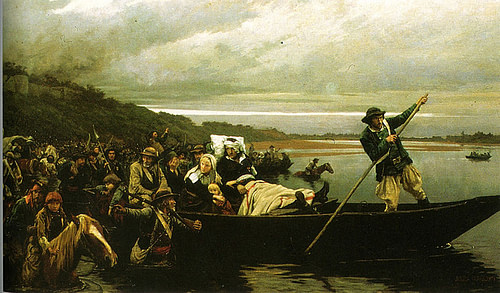
The army's greatest advantage was its familiarity with the land, which it used to great effect. Windmills in the lower hills were used to convey messages to units, while in the Loire boat patrols raided Republican supply lines. Guerilla tactics were used to surprise the blues, who often became trapped in the thick terrain of the bocage, serving to both frustrate and frighten Republican soldiers. At its peak, the Catholic and Royal Army had 40,000 soldiers and was often accompanied by the soldiers' families, a fact later used by Republicans to accuse the whole region of treason.
The Northwind Turn
With the Vendée firmly in rebel control, Cathelineau looked to take the war to enemy soil. On 18 June, he seized the town of Angers, and a week later, he laid siege to the wealthy city of Nantes. Here, he hoped to garner assistance from the British, who were looking for a safe place to land an invasion force. Yet, Nantes was formidably defended by 5,000 seasoned blues, reinforced by an additional 5,000 National Guardsmen. The confident whites attacked in force on 29 June and were defeated, suffering an even greater loss when Cathelineau was wounded by a sharpshooter; the Saint of Anjou succumbed to his wounds two weeks later.
The Battle of Nantes, therefore, could rightfully be considered the high watermark of the Vendean revolt, as it had been the moment when the Republic was most in danger; had Nantes fallen, the rebels easily could have threatened Paris. But the defeat of the invincible Catholic and Royal Army allowed time for experienced Republican troops to filter into the Vendée. By summer's end, there were 75,000 of them in the region. On 17 October, the blues decisively defeated the whites at Cholet, seizing the Vendean capital. Atrocities against civilians committed by both sides intensified; in the town of Montaigu, the whites completely filled a 240-foot (73 m) hole with the bodies of dead 'patriots', and the blues retaliated by throwing scores of rebels into a deep well, many of whom were still alive. Under the command of Jean-Baptiste Carrier, the Republicans spent the winter of 1793-94 drowning thousands of Vendean prisoners in the Loire, in the Drownings at Nantes.
With the Vendée falling, civilians began flocking to the protection of the Catholic and Royal Army, now under the command of the daring 21-year-old nobleman Henri de la Rochejaquelein. Rochejaquelein elected to lead his people north to incite Brittany and Normandy to revolt. In skiffs and makeshift rafts, 80,000 Vendeans, many of whom were civilians, crossed the Loire, beginning the bitter march that has been dubbed the Viree de Galerne, or the Northwind Turn.
For days on end, the Vendeans marched through the late autumn mud, as the winter chill set in. Often the only meals available were root vegetables dug from the ground, or unripe cider apples that caused widespread dysentery. Yet, for all their effort, the settlements north of the Loire did not rise in rebellion, and the starving and diseased Vendeans were defeated outside the well-fortified Norman port of Granville. Hesitantly, they turned and retreated, harried by Republican forces under General François-Joseph Westermann who picked off stragglers. Finally, on 10 December, Westermann attacked the withering Vendeans at the Battle of Le Mans, where over 10,000 of them were killed. The blues achieved a follow-up victory at the Battle of Savenay on 23 December; shortly after, Rochejaquelein was killed, and the Catholic and Royal Army was no more. The war had been won, but the slaughter was far from over.
Infernal Columns & Question of Genocide
Attacked on all sides, the young French Republic faced an existential struggle in the summer of 1793. In order to survive, it quickly realized it could not tolerate any form of internal dissent. This was one reason why Republican leaders came down with so much fury on Vendeans and other rebel groups. Early in the war, on 19 March, the National Convention ignored the rebellion's nuances and labelled it an 'aristocratic conspiracy', ordering anyone sporting a white cockade to be shot within 24 hours. On 1 August, revolutionary politician Bertrand Barère called for measures to be taken to "exterminate this rebel race," demanding that the Vendée be reduced to an uninhabitable desert as an example to would-be traitors.
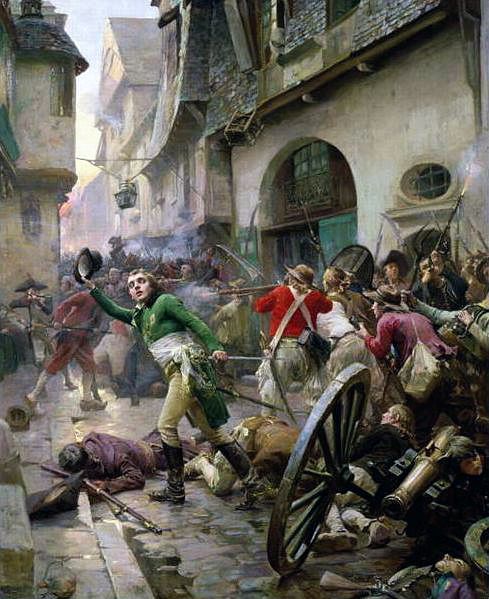
Following the Catholic and Royal Army's final defeat, the French Republic moved to make good on Barère's promise. In January 1794, twelve columns of 2-3,000 men each moved into the Vendée under the overall command of General Louis-Marie Turreau, who told his officers: "all means will be used to uncover the rebels; all will be put to the sword" (Bell, 179). Each of these columns, afterwards known as infernal columns, marched in a different direction across the Vendée, indiscriminately burning villages and crops, slaughtering livestock, plundering homes, and killing and raping Vendeans.
The limits of brutality varied from column to column; while some skewed closer to obeying the rules of war, or at least spared the lives of women and children, others murdered anyone they came across, even Vendeans who claimed to have remained loyal to the Republic. The blues' rationale was that anyone left in the Vendée must be a traitor, as all true patriots would have fled long ago. This was a purely punitive massacre that left tens of thousands dead before it fizzled out in March. Although Turreau at first attempted to reduce the Vendée into an uninhabitable desert as instructed, the dampness of the season made it difficult to start forest fires in the bocage, making this impossible. Still, an estimated 50,000 Vendeans perished, bringing the total number of Vendean deaths up to approximately 170,000, about 20% of their pre-war population.
The infernal columns are often the evidence cited by historians who claim the War in the Vendée was a genocide. At first glance, it is easy to see why. Yet, it is worth noting that the French and Vendeans were not two distinct races, nor did they view each other as such; Barère's use of the word 'race' in his speech contextually meant 'group', rather than the modern biological definition of the word. Moreover, the French government did not set out to exterminate the Vendeans completely but wished only to kill all the rebels. However, thanks to the Vendeans' use of guerilla warfare, such lines were often blurred, leading to the totality of the slaughter. Whether the Vendée can technically be considered genocide or not, the cost of human life was unarguably astounding, even in a period when Terror was the order of the day.
After the infernal columns had left, the war was not quite over. Pockets of Vendean resistance survived, led by Jean-Nicolas Stofflet and François de Charette, who had been commanding rebels since the beginning. For two years, the two continued with their guerilla tactics, disappearing back into the bocage before the blues could offer battle. In 1795, the Republic sent the celebrated General Lazare Hoche into the Vendée to deal with them. Rather than utilizing terror, Hoche successfully kept the remaining population neutral and was able to root out first Stofflet and then Charette, who were both shot in early 1796. With their deaths, the War in the Vendée was over, although Vendean resistance was not; the region would rise again several more times, in 1799, 1814, and again in 1815 against Napoleon's return in the Hundred Days.

